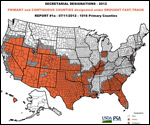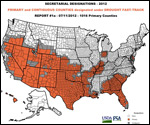
Water Security: The Need to Engage with Rural Communities
 The United States is currently experiencing one of the worst droughts in its history. 55% of the nation is enduring drought conditions, and the toll of insufficient precipitation will soon trickle down to the consumer. Supermarkets are expected to raise the prices of goods such as milk, cheese, and meat in the coming months.
The United States is currently experiencing one of the worst droughts in its history. 55% of the nation is enduring drought conditions, and the toll of insufficient precipitation will soon trickle down to the consumer. Supermarkets are expected to raise the prices of goods such as milk, cheese, and meat in the coming months.
This drought – although not yet the worst on record – will test the country’s ability to deal with water shortages that could become more frequent in the 21st Century. Changing conditions in the climate are likely to lead to more frequent and severe water scarcities like this. The current drought should serve as a barometer in judging how adept the country is at combating one of the consequences of global warming.
Other countries have already faced issues of water scarcity, which at times places government and farming communities at loggerheads. Australia, which experienced severe drought throughout much of its eastern half from 1997-2009, is one such example.
The U.S. can learn some lessons from Australia’s experiences. In Australia, the Murray-Darling Basin Authority is the government agency assigned with constructing the eponymous water plan: The Murray Darling Basin Plan (MDBP). It has been given the duty of creating more sustainable water allocations in Australia since the Millennium Drought. The MDBP is attempting to oversee a restoration of what scientists believe is an ailing Murray-Darling river system, and deal with the impacts of future droughts in the region. The river system is essential to agricultural industries in three of Australia’s four most populous states.
The first draft of the plan, released in October 2010, was met with extreme hostility in local farming communities. Organized mass burnings of the plan were held in rural towns in response to proposed cuts of 27-37 per cent of water allocations for farmers. The original plan attempted to place 2,750 gigalitres of water back in to the river system and reduce groundwater extraction by 4,340 gigalitres. Farmers would be compensated by the Federal Government forcing farmers to sell some of the water they had already purchased back to the Government.
The Government has allocated a budget of $140 million to buy back water from farmers, with 117 gigalitres of permanent water entitlements being purchased by the Australian Government (note: some purchases are still subject to legal due diligence checks before water sale contracts will be issued).
A second watered-down draft has since been sent out, and has again been met with hostility. A compromised 3,184 gigalitre cuts to groundwater extraction in the second version of the plan has drawn criticism from farmers as well as scientists, who believe reduced cuts will result in little improvement to the river system it is aiming to save.
The key problem with the plan is one that is systematic with Australian politics of late: communication. Rural populations affected by the plan in New South Wales, Victoria, and South Australia were never consulted. Nor were they given measures to help absorb the impacts that forced water buybacks from the Federal Government would cause.
Rural American communities should look at what has occurred in Australia with the MDBP and take note. Steps that will ensure water stability and stronger capabilities to cope with more frequent and harsh droughts in the 21st century must take into account the human costs as well as environmental. States heavily reliant on agriculture such as Texas – where 1 in 7 is in an agriculture-related job – must continue to find more effective ways to use water to mitigate the impacts of severe drought.
Government intervention in water security in Australia resulted from a perceived failure by rural communities around the Murray-Darling basin to establish sustainable water practices in the face of climate change. If analogous communities in the U.S. wish to avoid such a fate, then they must continue to find alternative industries and more effective allocations of water that to absorb impacts of drought.





